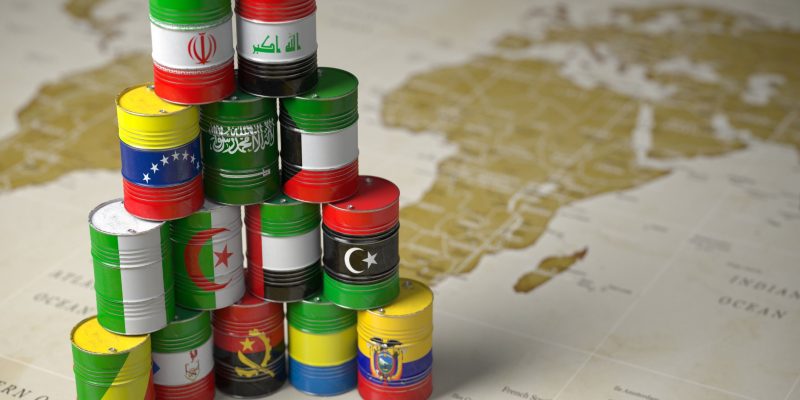
The surprising decision of the Organization of the Petroleum Exporting Countries and allies to increase oil production by a hefty amount for May leaves the market better supplied over April-June.
However, there is still uncertainty around this. The move by OPEC+ has battered oil prices, with global oil benchmarks declining sharply over the last couple of sessions.
Experts said oil prices are expected to remain under pressure as concerns over supply surplus escalate.
“It is unclear what the group decides to do with production from June onwards. We will have to wait until early May for a decision on this,” Warren Patterson, head of commodities strategy at ING Group, said in a note.
ING’s forecast assumes that OPEC will maintain production levels through June and July, and then gradually decrease output from August onward.
The substantial risk is that the group will advance the gradual supply increases by two months, instead of pausing them after May.
Oil market surplus
“This would only further increase the expected surplus over 2025, particularly in the fourth quarter,” Patterson said.
Eight OPEC+ producers (the OPEC-8)—Saudi Arabia, Russia, Iraq, UAE, Kuwait, Kazakhstan, Algeria, and Oman—confirmed an accelerated crude oil output increase of 411,000 barrels per day, starting in May 2025, during Thursday’s ministerial meeting.
This adjustment, equivalent to three monthly increments, exceeds the market’s prior expectation of a 135,000 barrels per day hike for May, as reflected in pre-meeting forecasts.
The move is a part of the cartel’s broader plan of unwinding the 2.2 million barrels per day of voluntary production cuts borne by eight OPEC+ members, including Saudi Arabia and Russia.
In April, OPEC members are expected to increase oil production by 135,000 barrels per day.
“The decision signals OPEC+’s confidence in the market’s ability to absorb additional supply, though it introduces new complexities given persistent macroeconomic uncertainties, fluctuating demand signals, and geopolitical risks,” said Mukesh Sahdev, global head of commodities market, oil at Rystad Energy.
Demand remains sketchy
Deteriorating global oil demand this year has added to the concerns of the market as well.
Demand estimates have been trimmed as the first quarter has progressed, and the announcement of reciprocal tariffs means that further potential revisions lower in demand are likely, given the impact that tariff escalation will have on global growth.
For now, ING Group estimates that oil demand worldwide is likely to grow by 1 million barrels per day with risks skewed to the downside.
According to the International Energy Agency, global oil demand is likely to increase by just over 1 million barrels per day in 2025.
The estimates have been trimmed slightly by the IEA over the last couple of months.
Due to an unusually uncertain macroeconomic environment and recent delivery data falling short of expectations, growth forecasts for 4Q24 and 1Q25 have been slightly lowered to 1.2 million barrels per day on a year-on-year basis, IEA further said.
Revised prices
As a result of the uncertain demand picture this year, the ING Group has trimmed its forecast for global oil prices in 2025.
The agency now sees Brent crude oil prices averaging around $72 per barrel in 2025 against its previous projection of $74 per barrel.
In the fourth quarter of the year, Brent oil is expected to average $68 per barrel, from the earlier estimate of $71 a barrel.
“For now, our balance continues to show a modest deficit over 2Q25 and 3Q25, supporting our view that prices over this period should move modestly higher from current levels,” Patterson said.
However, this can change quickly, depending on OPEC+ policy and demand developments.
Brent prices have fallen below the $70-per-barrel mark on Friday as US President Donald Trump’s reciprocal tariffs and OPEC’s supply increase weighed on the market.
At the time of writing, the price of Brent was at $67.69 per barrel, down 3.5% from the previous close.
Prices had fallen to $67.47 a barrel earlier today, their lowest level since December 2021.
Sahdev said:
With potential supply disruptions stemming from sanctions and tariffs—on both sellers and buyers—oil prices are unlikely to stay below $70 for long.
Why OPEC+ opted for a larger output increase
OPEC+’s supply increase appears to be driven by more than just a positive outlook, despite their official statement.
OPEC+ might see an opportunity to increase supply due to US President Trump’s stricter sanctions and hawkish stance towards Iran and Venezuela, according to ING Group.
Trump’s announcement of secondary tariffs for buyers of Venezuelan oil and threats of similar measures for buyers of Iranian and Russian oil could further incentivise OPEC+ to boost supply, it said.
“Secondly, it is no secret that Trump wants lower oil prices and has pressured the Saudis to boost supply,” Patterson said.
“This recent move might indicate that Trump has been more successful than many anticipated in persuading the Saudis to increase supply.”
Additionally, some speculate that the group resolved to raise the supply in order to penalise members who have repeatedly exceeded their production goals.
Members who have produced above their production targets have agreed to compensation cuts, however, yesterday’s move could suggest that there is little belief that members will actually follow through with these compensation plans.
The post Analysis: What does OPEC’s supply increase means for oil prices? appeared first on Invezz






